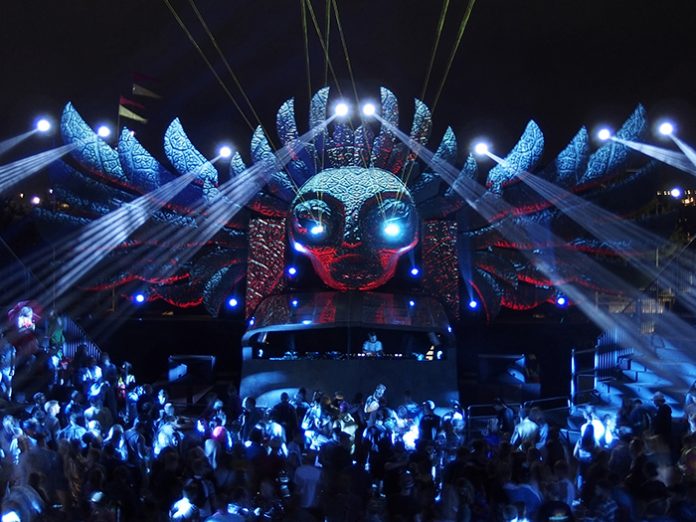Two Avolites Ai R6 media servers and an Arena lighting console running the latest Ai and Titan software were chosen to control the high-energy light and video package for the design relaunch of Glastonbury’s iconic dance stage, The Temple.
The British media server and lighting controls manufacturer was called in for the third year running by Alan King of Rockin Horse – technical coordinator and production supplier for Block 9 and The Common – who designed and sourced lighting and lasers for The Temple, whilst also keeping an overview on video production.
“In 2015, Rockin Horse got Avolites involved in the Temple’s projection mapping as they needed a solid, industry standard server capable of complex projection to be central to the system,” said King. “This year we selected the Avolites Ai R6 media servers as they allowed all of the outputs to run from a single graphics card, ensuring synchronicity between the video feeds, and allowing for fast delivery of multiple layers of high resolution video content.”
The Temple’s new look saw a greatly expanded capacity and a redesign of the venue itself, focussing on the stage’s centrepiece: a true 3D screen in the form of a giant figurehead with a feathered head dress. The approximately 8m x 20m x 5m deep structure was projection mapped with high-quality video content for four successive nights during the festival.
Bristol based collective Limbic Cinema was the team responsible for the stage’s digital content and showtime operation. An Ai operation team, headed up by Avolites’ Arran Rothwell-Eyre, worked alongside Limbic Cinema to provide specialist on-site support and Ai training.
“The Temple’s project was based around a customised, six-layer system,” said Rothwell-Eyre, who engineered The Temple’s on-site VJ system. “This gave us four mixing layers and two assignable masking layers, all of which were running content in the AiM codec at a resolution of 2800 x 2800. A live input was also used to allow real-time capture of VDMX for generative content, which was controlled from both the Ai interface and using external Midi devices to allow hands-on, real-time operation of the system.”
“Ai v10’s tools allowed us to work through the setup quickly and easily,” continued Rothwell-Eyre. “We had a good 3D model of the screen surface itself, so once we had our projectors placed in the project we used the mapping editor to make any adjustments we needed. The majority of the mapping was done in one night and included multiple edge blends across the head as well as some masking coupled with Ai’s remove object function to reduce the complexity of the task in other areas.”
Supplying the stage’s projection hardware and full video package for the stage was Transition Video, who provided Barco HD20 projectors, fibre runs and video distribution. The fibre system allowed for content to be delivered with no loss of signal quality, ensuring a high level of clarity and brightness on the screens.
The comprehensive array of lighting fixtures and lasers throughout the venue were sourced from ColourSound and with some careful consideration and final placement on-site by long-term Avolites user and showtime operator Paul Devill, controlled expertly from an Arena console running Titan 10.1, they served well to expand on the depth of the video mapping and draw the whole of the production’s visuals tightly together.
“The entire team at The Temple are very proud of what was delivered this year,” noted Rothwell-Eyre. “The video and lighting worked really well together on the new and greatly enhanced structure, to create a highly immersive experience.
“The bar has now been set to a high standard in terms of production on The Temple, and the whole team fully intends push this higher every year. Expect even bigger, better and brighter things from The Temple!”he concluded.






